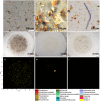White and wonderful? Microplastics prevail in snow from the Alps to the Arctic
- PMID: 31453336
- PMCID: PMC6693909
- DOI: 10.1126/sciadv.aax1157
White and wonderful? Microplastics prevail in snow from the Alps to the Arctic
Abstract
Microplastics (MPs) are ubiquitous, and considerable quantities prevail even in the Arctic; however, there are large knowledge gaps regarding pathways to the North. To assess whether atmospheric transport plays a role, we analyzed snow samples from ice floes in Fram Strait. For comparison, we investigated snow samples from remote (Swiss Alps) and populated (Bremen, Bavaria) European sites. MPs were identified by Fourier transform infrared imaging in 20 of 21 samples. The MP concentration of Arctic snow was significantly lower (0 to 14.4 × 103 N liter-1) than European snow (0.19 × 103 to 154 × 103 N liter-1) but still substantial. Polymer composition varied strongly, but varnish, rubber, polyethylene, and polyamide dominated overall. Most particles were in the smallest size range indicating large numbers of particles below the detection limit of 11 μm. Our data highlight that atmospheric transport and deposition can be notable pathways for MPs meriting more research.
Figures



References
-
- K. Silpa, L. Yao, P. Bhada-Tata, F. Van Woerden, What a Waste 2.0: A Global Snapshot of Solid Waste Management to 2050 (Urban Development, The World Bank, 2018).
-
- Jambeck J. R., Geyer R., Wilcox C., Siegler T. R., Perryman M., Andrady A., Narayan R., Law K. L., Plastic waste inputs from land into the ocean. Science 347, 768–771 (2015). - PubMed
-
- Lebreton L., Andrady A., Future scenarios of global plastic waste generation and disposal. Palgrave Commun. 5, 6 (2019).
-
- Bergmann M., Tekman M. B., Gutow L., Marine litter: Sea change for plastic pollution. Nature 544, 297 (2017). - PubMed
LinkOut - more resources
Full Text Sources

